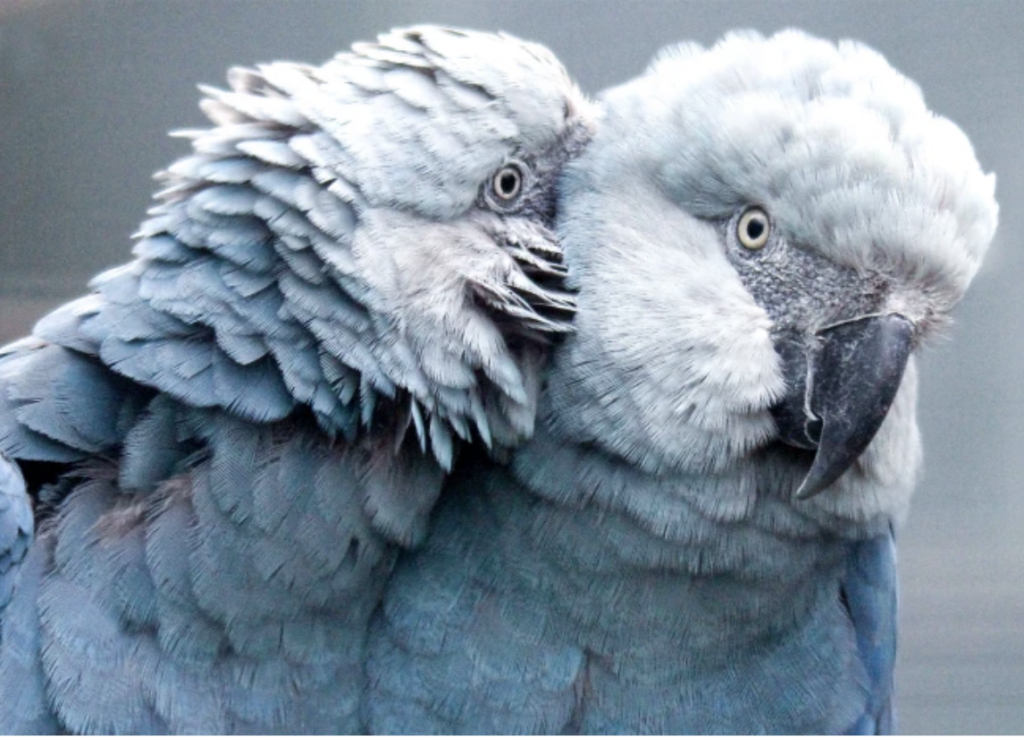Species in Peril:
SPIX's MACAW

Bringing them back from extinction
These birds are movie stars
Spix’s Macaw, the smallest of the blue macaw, was first discovered and documented in the early 19 century. In the two hundred years since its discovery, there were only a handful of observations of Spix’s Macaws in their natural habitat. In 2019, the species was officially declared to be extinct in the wild.
Due to the rarity of Spix’s Macaw, most people may never have a chance to meet these little blue parrots in person, but it is easy to know them from the screen. In 2011, via the animated movie “RIO”, two Spix’s Macaw as the leading role successfully brought the public’s attention to this endangered species. As qualified movie stars, Spix’s Macaws are quite distinguishable. The adult Spix’s Macaw has stunning dull blue plumage with a faint greenish tinge on the breast and abdomen. Spix’s Macaw was discovered in Brazil in 1819, and already at that time, this species was thought to be very rare. Since 2000, no Spix’s Macaw has been observed in the wild. And after several years of surveys, IUCN officially declared that this species is extinct in the wild in 2019.
Human greed and Poaching
It is reported that the locals have hunted these blue macaws for food or just for fun, but this is not the main reason why their population decreased. It is Spix’s Macaws’ beauty that makes them famous in the world, but this feature also attracts greedy people who bring disasters to them.
From last century, the trappers not only captured the adults but also removed their nesting and eggs from nests for illegal bird trade. Even in that time, the collectors were willing to pay up to $40,000 for a Spix’s Macaw.And nowadays, in the black market the captive birds could be worth five times or more that amount. Due to the monetary value of Spix’s Macaws and the lack of research on them, there are a lot of difficulties the protection activities for Spix’s Macaws need to overcome.
Efforts to bring them back
After two decades of the Spix’s Macaws vanishing in the wild, the conservationists never give up on rebuilding the population in the wild. There is exciting news that, in 2022, twenty Spix’s Macaws will be released by the end of year.
The released birds from captivity are expected to be the vanguard of a new population in their natural habitat, caatinga, a tropical dry forest in northeastern Brazil. This reinduction plan is so ambitious that no one could promise if it will succeed or not.
The project is estimated that at least one-third of the birds will be lost in the first year, and if the loss is too high, the left birds might be taken back in. But although there are so many uncertainties, the scientists still hold hope for this plan. Andy they also believe that the protection project for flagship will help preserve and restore the Spix’s Macaws’ habitat, and help many other species too.
A Few More Facts About Spix's Macaws
- It is estimated that life expectancy of Spix’s Macaw can be up to 40 years.
- The African bee is one of the treats to Spix’s Macaw. They compete with Spix’s Macaw for nesting sites and kill the chicks.
- The animated movie “Rio” was inspired by the story of the last wild Spix’s Macaw.
- The last wild Spix’s Macaw is a male and paired up with a female Blue-winged or Illiger’s Mini Macaw.
- Scientists release a female Spix’s Macaw to re-pair with the last wild survivor, but unfortunately, they didn’t yield any young.
Video: Saving the Spix's Macaw
(by ACTP)
Species Name
Cyanopsitta spixii
Estimated Population
160 in captivity.
Conservation Status
Extinct in the wild. Project to reintroduce them exist.
Range
Brazil
Reasons for Population Decline
Illegal wildlife trafficking
Habitat loss
Hunting and trapping (poaching)


